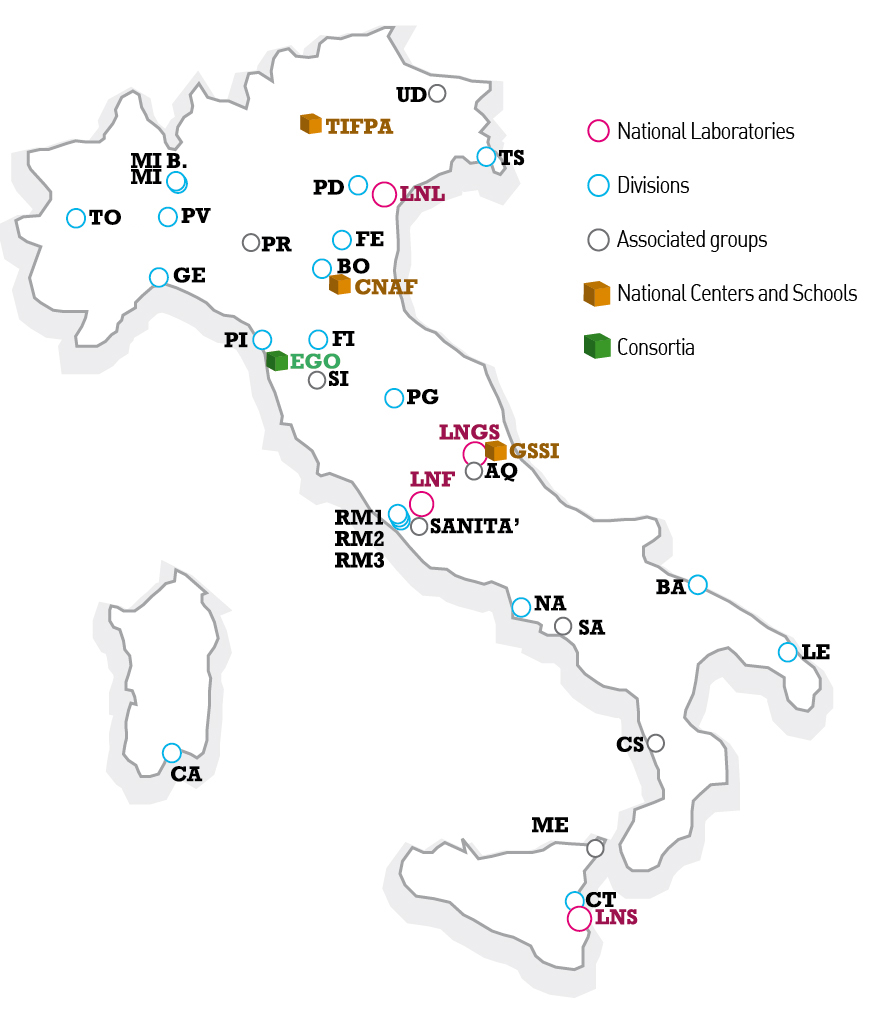QUANTUM
Quantum Systems: entanglement, simulations, information
SELECTED PUBLICATIONS
1. S. Notarnicola, E. Ercolessi, P. Facchi, G. Marmo, S. Pascazio, F.V. Pepe, Discrete Abelian Gauge Theories for Quantum Simulations of QED, J. Phys. A: Math. Theor. 48 30FT01 (2015)
2. T. Pichler, M. Dalmonte, E. Rico, P. Zoller and S. Montangero, Real-Time Dynamics in U(1) Lattice Gauge Theories with Tensor Networks, Phys. Rev. X 6, 11023 (2016)
3. A. H. Werner, D. Jaschke, P. Silvi, M. Kliesch, T. Calarco, J. Eisert and S. Montangero, Positive Tensor Network Approach for Simulating Open Quantum Many-Body Systems, Phys. Rev. Lett. 116, 237201 (2016).
4. F. Benatti, F. Carollo, R. Floreanini and H. Narnhofer, Quantum fluctuations in mesoscopic systems, J. Phys. A 50, 423001 (2017)
5. F. Benatti, F. Carollo, R. Floreanini and J. Surace, Long-lived mesoscopic entanglement between two damped infinite harmonic chains, J. Stat. Phys. 168, 620 (2017)
6. G. Benenti, G. Casati, K. Saito and R.S. Whitney, Fundamental aspects of steady-state conversion of heat to work at the nanoscale, Phys. Rep. 694, 1 (2017).
7. G. Bimonte, T. Emig, M. Kardar e M. Kruger, Nonequilibrium Fluctuational Quantum Electrodynamics: Heat Radiation, Heat Transfer, and Force, Ann. Rev. Cond Matt. 8, 119 (2017).
8. P.A. Erdman, F. Mazza, R. Bosisio, G. Benenti, R. Fazio and F. Taddei, Thermoelectric properties of an interacting quantum dot based heat engine, Phys. Rev. B 95, 245432 (2017).
9. G. Gianfelici, S. Mancini, Quantum channels from reflections on moving mirrors, Scientific Reports 7, 15747 (2017)
10. B. Militello, H. Nakazato, A. Napoli, Synchronizing Quantum Harmonic Oscillators through Two-Level Systems, Phys. Rev. A 96, 023862 (2017)
11. F.V. Pepe, F. Di Lena, A. Mazzilli, E. Edrei, A. Garuccio, G. Scarcelli, M. D'Angelo, Diffraction-limited plenoptic imaging with correlated light, Phys. Rev. Lett. 119, 243602 (2017)
12. F. Benatti, F. Carollo, R. Floreanini and H. Narnhofer, Quantum spin chain dissipative mean-field dynamics, J. Phys. A 51, 325001 (2018)
13. F. Benatti, Dynamics, Information and Complexity in Quantum Systems, Theoretical and Mathematical Physics (Springer-Verlag 2009)
14. E. Ercolessi, P. Facchi, G. Magnifico, S. Pascazio, F. V. Pepe, Phase Transitions in Zn Gauge Models: Towards Quantum Simulations of the Schwinger- Weyl QED, Phys. Rev. D 98, 074503 (2018)
15. L. Ferro, R. Fazio, F. Illuminati, G. Marmo, S. Pascazio, and V. Vedral, Measuring quantumness: from theory to observability in interferometric setups, Eur. Phys. J. D 72, 219 (2018).
16. R. Heck, et al., Remote optimization of an ultracold atoms experiment by experts and citizen scientists, Proc. Natl. Acad. Sci. 115, E11231 (2018).
17. M. Laudato, G. Marmo, F. Mele, F.Ventriglia, P. Vitale, Tomographic reconstruction of quantum metrics., J. Phys. A: Math. Theor. 51, 1751 (2018).
18. R. Luo, G. Benenti, G. Casati and J. Wang, Thermodynamic bound on heat-to-power conversion, Phys. Rev. Lett. 121, 080602 (2018).
19. S. Montangero, Introduction to Tensor Network Methods (Springer-Verlag, 2018).
20. M. Salerno, F. K.h. Abdullaev, Flat bands and dynamical localization of spin-orbit-coupled Bose-Einstein condensates, Phys. Rev. A 98, 053606 (2018).
21. P. Aniello, A class of stochastic products on the convex set of quantum states, J. Phys. A: Math. Theor. 52, 305302 (2019).
22. V. Balachandran, G. Benenti, E. Pereira. G. Casati and D. Poletti, Heat current rectification in segmented XXZ chains, Phys. Rev. E 99, 032136 (2019).
23. F. Benatti, S. Mancini, S. Mangini, Continuous variable quantum perceptron, Int. J. Quant. Inf. 17, 1941009 (2019)
24. D. Burgarth, P. Facchi, H. Nakazato, S. Pascazio, K. Yuasa, Generalized Adiabatic Theorem and Strong Coupling Limits, Quantum 3, 152 (2019)
25. A. Crespi, F.V. Pepe, P. Facchi, F. Sciarrino, P. Mataloni, H. Nakazato, S. Pascazio, R. Osellame, Experimental investigation of quantum decay at short, intermediate and long times via integrated photonics, Phys. Rev. Lett. 122, 130401 (2019)
26. A.V. Dodonov, A. Napoli and B. Militello, Emulation of n-photon Jaynes-Cummings and anti-Jaynes-Cummings models via parametric modulation of a cyclic qutrit, Phys. Rev. A 99, 033823 (2019).
27. T. Haug, R. Dumke, L.-C. Kwek, L. Amico, Topological pumping in atomtronic circuits, Communications Physics 2, 127 (2019)
28. G. Magnifico, D. Vodola, E. Ercolessi, S. P. Kumar, M. Muller, A. Bermudez, Symmetry-protected topological phases in lattice gauge theories: topological QED2, Phys. Rev. D 99, 014503 (2019)
29. P. Naldesi, J. P. Gomez, A. Minguzzi, B. Malomed, M. Olshanii, L. Amico, Raise and fall of a bright soliton in an optical lattice, Phys. Rev. Lett. 122, 053001 (2019)
30. A. Omran, et al., Generation and manipulation of Schrödinger cat states in Rydberg atom arrays, Science 365, 570 (2019).
31. M. Rexiti, S. Mancini, Adversarial vs cooperative quantum estimation, Quantum Information Processing 18, 102 (2019)
32. M. M. Wauters, A. Russomanno, R. Citro, G.E. Santoro, L. Privitera, Localization, Topology, and Quantized Transport in Disordered Floquet Systems, Phys. Rev. Lett. 123, 266601 (2019).
33. G. Ghelli, G. Magnifico, C. Degli Esposti Boschi, E. Ercolessi, Topological phases in two-legged Heisenberg ladders with alternated interactions, Phys. Rev. B 101, 085124 (2020)
34. T. Haug, L. Amico, L.-C. Kwek, W.J. Munro, V.M. Bastidas, Topological pumping of quantum correlations, Phys. Rev. Res. 2, 013135 (2020).
35. R. Grimaudo, A. Messina, A. Sergi, N. Vitanov, S. Filippov, Two-qubit entanglement generation through non-Hermitian Hamiltonians induced by repeated measurements on an ancilla, Entropy 22, 1184 (2020).
36. G. Magnifico, M. Dalmonte, P. Facchi, S. Pascazio, F.V. Pepe, E. Ercolessi, Real Time Dynamics and Confinement in the Zn Schwinger-Weyl lattice model for 1+1 QED, Quantum 4, 281 (2020)
37. J. Wang, G. Casati and G. Benenti, Inverse currents in Hamiltonian coupled transport, Phys. Rev. Lett. 124, 110607 (2020).
38. A. Grimaldi, A. Sergi, A. Messina, Evolution of a Non-Hermitian Quantum Single-Molecule Junction at Constant Temperature, Entropy 23, 147 (2021).

